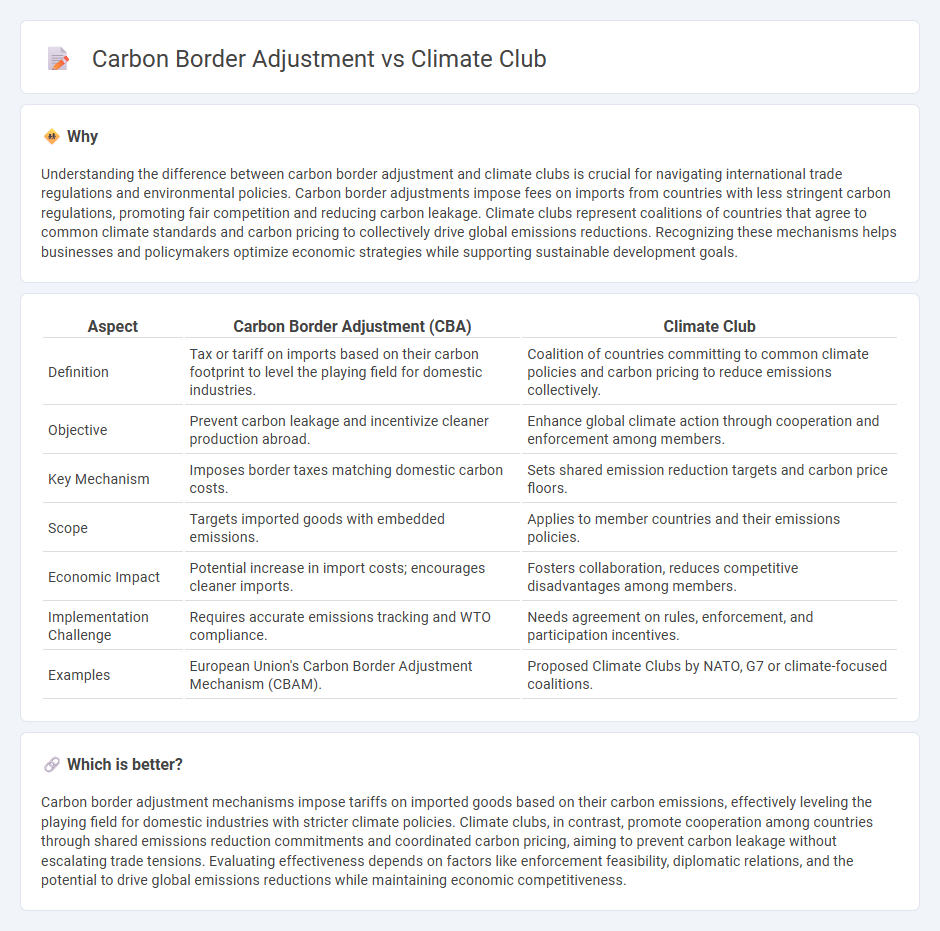
Carbon border adjustment mechanisms impose tariffs on imported goods based on their carbon emissions to prevent carbon leakage and promote global emission reductions, while climate clubs encourage countries to commit jointly to ambitious climate policies through incentives and cooperation. Understanding the economic impacts and policy effectiveness of these approaches is crucial for shaping international climate action and trade dynamics. Explore deeper insights into how these strategies influence global markets and environmental outcomes.
Why it is important
Understanding the difference between carbon border adjustment and climate clubs is crucial for navigating international trade regulations and environmental policies. Carbon border adjustments impose fees on imports from countries with less stringent carbon regulations, promoting fair competition and reducing carbon leakage. Climate clubs represent coalitions of countries that agree to common climate standards and carbon pricing to collectively drive global emissions reductions. Recognizing these mechanisms helps businesses and policymakers optimize economic strategies while supporting sustainable development goals.
Comparison Table
| Aspect | Carbon Border Adjustment (CBA) | Climate Club |
|---|---|---|
| Definition | Tax or tariff on imports based on their carbon footprint to level the playing field for domestic industries. | Coalition of countries committing to common climate policies and carbon pricing to reduce emissions collectively. |
| Objective | Prevent carbon leakage and incentivize cleaner production abroad. | Enhance global climate action through cooperation and enforcement among members. |
| Key Mechanism | Imposes border taxes matching domestic carbon costs. | Sets shared emission reduction targets and carbon price floors. |
| Scope | Targets imported goods with embedded emissions. | Applies to member countries and their emissions policies. |
| Economic Impact | Potential increase in import costs; encourages cleaner imports. | Fosters collaboration, reduces competitive disadvantages among members. |
| Implementation Challenge | Requires accurate emissions tracking and WTO compliance. | Needs agreement on rules, enforcement, and participation incentives. |
| Examples | European Union's Carbon Border Adjustment Mechanism (CBAM). | Proposed Climate Clubs by NATO, G7 or climate-focused coalitions. |
Which is better?
Carbon border adjustment mechanisms impose tariffs on imported goods based on their carbon emissions, effectively leveling the playing field for domestic industries with stricter climate policies. Climate clubs, in contrast, promote cooperation among countries through shared emissions reduction commitments and coordinated carbon pricing, aiming to prevent carbon leakage without escalating trade tensions. Evaluating effectiveness depends on factors like enforcement feasibility, diplomatic relations, and the potential to drive global emissions reductions while maintaining economic competitiveness.
Connection
The carbon border adjustment mechanism imposes tariffs on imported goods based on their carbon emissions, encouraging countries to adopt greener practices. Climate clubs, formed by nations committing to ambitious climate goals, reinforce this by establishing common standards that reduce carbon leakage and promote global emissions reductions. Together, they incentivize international cooperation and economic alignment toward sustainable development.
Key Terms
Carbon pricing
Climate clubs establish cooperative agreements among countries to implement uniform carbon pricing mechanisms, fostering collective climate action and reducing competitive disadvantages. Carbon border adjustments impose tariffs on imported goods based on their carbon content, incentivizing cleaner production abroad and preventing carbon leakage. Explore how these strategies interact to shape effective global carbon pricing policies.
Trade barriers
Climate clubs create cooperative frameworks where member countries commit to climate policies, reducing trade barriers by harmonizing standards and avoiding carbon leakage. Carbon border adjustment mechanisms impose tariffs on imports from countries lacking similar carbon pricing, acting as trade barriers to protect domestic industries and incentivize global emissions reduction. Explore further to understand how these approaches shape international trade and environmental policy.
Emissions leakage
Climate clubs are cooperative agreements among countries to set unified climate policies and emission reduction targets, mitigating emissions leakage by creating a level playing field. Carbon border adjustment mechanisms (CBAM) levy taxes on imported goods based on their carbon content to prevent carbon leakage by discouraging shifting emissions-intensive production to jurisdictions with looser regulations. Explore how these strategies interrelate and their impact on global emissions dynamics for a deeper understanding.
Source and External Links
Climate club - The Climate Club is an international initiative launched by the G7 in 2022 aimed at global cooperation to reduce greenhouse gas emissions and accelerate decarbonization, especially in industrial sectors, by fostering collaboration without punitive trade measures.
G7 climate club - European Parliament - The Climate Club endorsed by G7 leaders in 2022 is an open, inclusive coalition focused on advancing climate mitigation policies, industrial transformation, and strengthening international cooperation to achieve net-zero emissions by 2050.
The Climate Club, industry decarbonisation - The Climate Club - An intergovernmental forum with 46 members dedicated to exchanging knowledge and driving collective action on industrial decarbonization, supporting policy and investment frameworks to address carbon leakage and accelerate the green transition.
 dowidth.com
dowidth.com